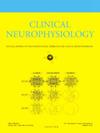A novel TMS framework for assessing neurophysiological recovery at the subacute stage after stroke
IF 3.7
3区 医学
Q1 CLINICAL NEUROLOGY
引用次数: 0
Abstract
Objective
To use peri-threshold transcranial magnetic stimulation (TMS) intensities to elicit motor evoked potentials (MEPs) during the subacute stage after stroke and assess their association with upper limb motor recovery.
Methods
Twenty-five MEP+ patients participated in three sessions at 1, 3, and 6 months post-stroke. Single-pulse TMS across a range of stimulation intensities was used to elicit MEPs in four muscles of the paretic and non-paretic upper limb. At each timepoint, threshold matrices were constructed based on MEP amplitude and persistence. A matrix element was suprathreshold if five out of ten stimulations elicited MEPs ≥ 50 μV. A subthreshold element produced MEPs below this criterion. Dexterity was assessed using the nine hole peg test.
Results
There were fewer suprathreshold, and more subthreshold elements on the paretic compared to the non-paretic side. The number of suprathreshold elements on the paretic side increased between 1 and 6 months post-stroke. Neither sub- nor supra-threshold elements were associated with dexterity recovery.
Conclusion
The proportion of sub- and supra-threshold elements reflect neurophysiological recovery during the subacute stage after stroke. A threshold matrix framework can identify patients with stable versus dynamic neurophysiology post-stroke.
Significance
A compositional analysis framework can quantify neurophysiological recovery after stroke.
求助全文
约1分钟内获得全文
求助全文
来源期刊

Clinical Neurophysiology
医学-临床神经学
CiteScore
8.70
自引率
6.40%
发文量
932
审稿时长
59 days
期刊介绍:
As of January 1999, The journal Electroencephalography and Clinical Neurophysiology, and its two sections Electromyography and Motor Control and Evoked Potentials have amalgamated to become this journal - Clinical Neurophysiology.
Clinical Neurophysiology is the official journal of the International Federation of Clinical Neurophysiology, the Brazilian Society of Clinical Neurophysiology, the Czech Society of Clinical Neurophysiology, the Italian Clinical Neurophysiology Society and the International Society of Intraoperative Neurophysiology.The journal is dedicated to fostering research and disseminating information on all aspects of both normal and abnormal functioning of the nervous system. The key aim of the publication is to disseminate scholarly reports on the pathophysiology underlying diseases of the central and peripheral nervous system of human patients. Clinical trials that use neurophysiological measures to document change are encouraged, as are manuscripts reporting data on integrated neuroimaging of central nervous function including, but not limited to, functional MRI, MEG, EEG, PET and other neuroimaging modalities.
 求助内容:
求助内容: 应助结果提醒方式:
应助结果提醒方式:


